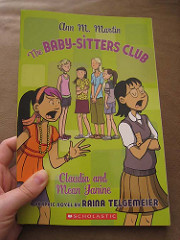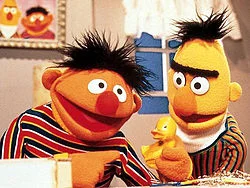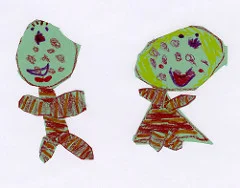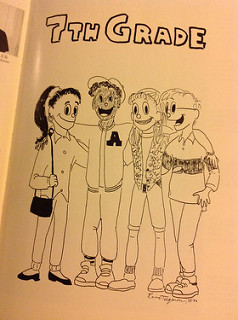What is Style?
Where does style come from? How do you develop one?
A few years ago, I got the chance to turn one of my favorite prose book series, The Baby-sitters Club, into a series of graphic novels.
Here’s the original cover of The Baby-sitters Club: Claudia and Mean Janine, then the cover of my adaptation, and an interior spread.
When my graphic novels debuted, some readers were taken aback because my style is so different from the original portrayal of the characters. It’s true: My artwork has a pretty distinct style. How would you describe it? Some people have used words like cartoony, rounded, smooth, appealing, friendly, retro, warm, young, and loopy to describe my work. This stands in contrast to the original series’ covers, which you might describe as realistic, painterly, or very 1980s. (Were the 1980s a style?! Some people argue that they were…)
I certainly wasn’t born drawing the way I do. I’ve spent the past three or so decades practicing and refining my work. With that in mind, let’s think about this question: Where does style come from?
1. Influences
From very early on, I loved watching cartoons and anything animated. Some of my favorites were Scooby Doo, the Smurfs, the Care Bears, and anything Disney. I also loved the Muppets on Sesame Street, Berenstain Bears books, and Mickey Mouse.
Early influences.
My earliest drawings are just scribbles and shapes, but they’re all sort of rounded, featuring a lot of bubble-headed figures.
Some of my early masterpieces.
When I was nine, I discovered comic strips in the newspaper. I fell instantly in love with Calvin and Hobbes, For Better or For Worse, FoxTrot, and Luann. And these characters didn’t need huge animation studios to make them live and breathe…they just needed some word balloons and a few panels to play around in!
I made my first comics around the age of 10. I wish I had some to show you–but I don’t! They’re either lost to the sands of time, or buried in a box somewhere in my mom’s storage space.
2. Copying
It’s fun to draw other peoples’ characters sometimes! Here’s Tree Trunks, from Adventure Time, and Tintin and Snowy from Tintin, by me.
For a while, I just copied my favorite characters in my sketchbooks. In some cases, I even traced them. There’s nothing wrong with this—I think learning how other artists fit shapes together is a really helpful way to learn to draw. Then, I began to invent my own characters, which usually bore a striking resemblance to my favorite cartoons and comics…like a detective named Inspector Lock-It, who had a nephew and a cat (pretty much ripping off Inspector Gadget, with a little bit of genderswap and species-swap going on). I also drew myself, my friends, my teachers, my family…anybody I came in contact with was likely a subject of my comics!
An illustration from my middle school yearbook. Age 12 or so. For a while, a key part of my drawing style was to give characters a circle for a nose!
I continued to draw all of my favorite cartoons, and became somewhat famous in my middle school for being the “girl who could draw anything.” The Simpsons, the Teenage Mutant Ninja Turtles, the Little Mermaid…people ‘commissioned’ me all the time, and lots of people stuck my drawings in the fronts of their binders, proudly on display. I guess this was my fanart stage, and if Tumblr had existed in those days, I would have gotten a lot of notes!
By the time I got to high school, my style was starting to “gel.” People could tell when something was a “Raina drawing.” I had a great time in high school, painting dance posters, drawing comics for the school paper, illustrating as many of my class assignments as possible, and drawing caricatures of my friends and teachers.
Creating a giant dance poster for school! (Fun facts: In Smile, you see my character creating posters much like this one! And the person painting with me in this photo is my amazing friend Jake, who inspired the character of Jesse in my book Drama!)
3. Art Class, Art School
Eventually I went to art college–The School of Visual Arts, in New York City. Here is where they “teach” you to draw the “right” way. I really enjoyed my illustration classes, painting, comics-making classes, and especially figure drawing classes, learning about human anatomy and trying to capture difficult poses…but, my faces were always cartoony. My teachers hated this! But I was beginning to realize that cartoony faces are a huge, ingrained part of my “style” of drawing. (You could also call it a crutch.) Once I finished college, I was happy to just embrace my own style, and started making comics nonstop.
4. Tools
The tools you use will certainly have an impact on your style. Do you draw with a brush? A pen? A computer? Do you use paints, or charcoal? Crayons or markers?
Here are two unrelated comics pages I drew during college. The first is from when I was still inking with pens and markers…the second is after I switched over to inking with a brush.
5. Day in and day out.
Another huge factor in an artist’s style is time. Try drawing the same character every day, over the period of a month, a year, five years. The first will probably look different than the last. Styles can change a lot over time, due to many things: your hand memorizes certain lines and shapes, and starts to simplify them. You start to take certain shortcuts. You find yourself always drawing things in a certain order. Eventually, you can practically draw your characters with your eyes closed!
I’m sure my style will continue to evolve over the years, but an amazing thing has happened:
The characters from Drama, as drawn by Alyssa!
Some of the young readers of my work are starting to try to draw like me. Some of them might even list me as an influence on their own style, someday.
And I can think of no greater compliment.
This essay was originally posted on Inside A Dog. © Raina Telgemeier.



















